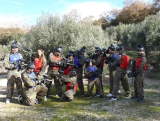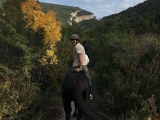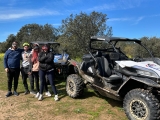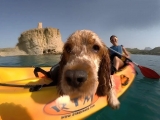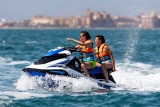The descent can be done solo in a canoe or kayak, as a couple or in a group. For groups, the descent along the River Deva is typically done in a rafting inflatable boat. That said, knowing how to swim is always an essential requirement for the descent, as you must always respect the river's waters. Additionally, wearing a properly fitted buoyancy aid is mandatory to ensure flotation should you fall in.
There are different sections to tackle depending on the difficulty level.

For descending the River Deva, you'll normally use the same equipment as for other rivers. Firstly the kayak or canoe, or in the case of groups, the rafting boat. Then a full-face helmet for river adventure sports, wetsuit, water shoes or neoprene boots, and a paddle - single-bladed for rafting, double-bladed for kayak or canoe. Finally the buoyancy aid, which must always be properly secured to prevent movement and ensure safety.

The remaining equipment, including ropes, a small first-aid kit or raft repair tools in the case of rafting, will always be carried by the guide, who will supervise us and give paddling instructions throughout.
- Family rafting 7 km from €30. Grade III-IV. Section from Puente El Infierno to Puentelles (Minimum age 10-12 years)
- 2-hour rafting descent from €35 (Minimum age 14 years)
Kayak and Canoe descent offers
- 12 km descent from €35 Section from Panes to Unquera (Minimum age 8 years)
- 3-hour river descent from €23 Upper or lower section descent.
- 2-3 hour descent + picnic
- --> Child price €20 (under 13 years)
- --> Adult price €25 (Sections from Panes to Unquera)
Try any of these activities this spring-summer season packed with adventure.
The Deva welcomes thousands of adventure tourism enthusiasts who complete the river descent by paddling with the current, enjoying an unforgettable day on the water filled with thrills and adventure. All while surrounded by stunning natural scenery in the heart of Cantabria.
The River Deva originates in Fuente Dé, a town famous for its cable car that takes visitors up to routes leading to Aliva Refuge or Cabaña Verónica. Its waters then flow through Cantabria and Asturias over a total length of 64 kilometres. It empties into the Cantabrian Sea at Tina Mayor estuary. Its main tributary is the River Cares, 50 km long, famous for running through the Cares Route, one of the most famous hiking trails in northern Spain.

Along its course, the River Deva passes through the towns of Bustio (Ribadedeva), Vilde (Ribadedeva), Buelles (Peñamellera Baja), Panes, a village famous for being between Asturias and Cantabria (capital of Peñamellera Baja) and Cuñaba (Peñamellera Baja).
Regarding its name, it comes from a deity from the time of the Cantabrian warriors, the goddess known as Deva. This name, probably of Celtic origin, may be related to the word for god.
Fancy a descent?





